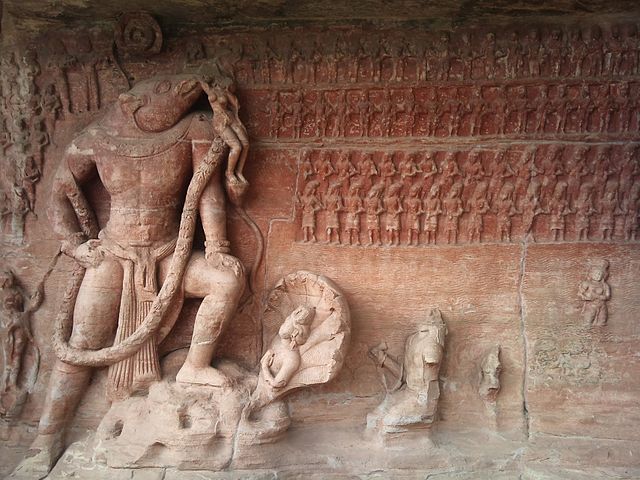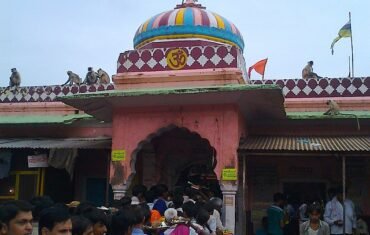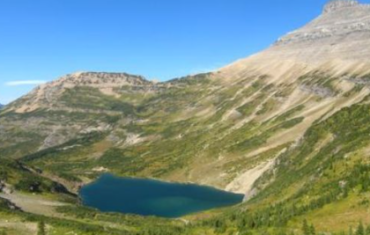Udaigiri Caves are a group of 20 rock-cut caves near Vidisha, Madhya Pradesh, that date back to the early years of the 5th century CE. They contain some of the oldest surviving Hindu temples and iconography in India, as well as some Jain sculptures. The caves are situated on a hill that overlooks the Betwa River, and are surrounded by lush greenery and natural beauty. Visit during One Day Bhopal to Sanchi-Udaigiri Trip by cab
The caves are also a part of the Sanchi World Heritage Site, and are a testimony to the religious and artistic diversity of ancient India. Best 10 Places To Visit in Bhopal
Overview of Udaigiri Caves

Udaigiri Caves were carved out of sandstone by the Gupta rulers, who were patrons of art and culture. The caves are numbered from 1 to 20, and are of different sizes and shapes. The caves are mostly dedicated to Hindu gods, such as Vishnu, Shiva, and Durga, and depict various scenes and stories from Hindu mythology.
The most famous and impressive cave is Cave 5, which has a colossal relief sculpture of Vishnu in his incarnation as the boar Varaha, rescuing the earth goddess Bhudevi from the demon Hiranyaksha. The sculpture is about 13 feet high and 11 feet wide, and is considered as one of the masterpieces of Indian art.
The caves also have some Jain sculptures, such as Cave 20, which has an image of the Tirthankara Parshvanatha, and Cave 19, which has an image of the Tirthankara Rishabhanatha. The caves also have inscriptions in Brahmi and Sanskrit, which provide information about the history and chronology of the Gupta period.
Location of Udaigiri Caves

Udaigiri Caves are located on the NH-86, near the town of Udaigiri, in the district of Vidisha, Madhya Pradesh, India. The caves are about 4 km from the Sanchi Stupa, and about 13 km from the Vidisha Railway Station. The caves are easily accessible by public transport, such as buses, taxis, and auto-rickshaws.
Timing/Entry Fees Udaigiri Caves
Udaigiri Caves are open to the public from 8:00 am to 6:00 pm, from Tuesday to Sunday. The caves are closed on Mondays and public holidays. The entry fee for the caves is Rs. 10 for Indian visitors and Rs. 250 for foreign visitors. There is no entry fee for children below 12 years, students, and senior citizens. There is an additional fee of Rs. 25 for photography and Rs. 50 for videography. The caves also offer guided tours and audio guides for a nominal charge.
How to Reach Udaigiri Caves

Udaigiri Caves can be reached by various modes of transport from different parts of Bhopal and other nearby cities. Some of the options are:
- By Bus: There are several buses that ply to Udaigiri Caves from various bus stops in Bhopal and other cities, such as Vidisha, Raisen, and Sagar. The nearest bus stop to the caves is the Udaigiri Bus Stop, which is about 500 meters away. Some of the bus routes that pass through this stop are 1, 2, 3, 4, 5, 6, 7, 8, 9, and 10[^1^][1].
- By Taxi: Taxis are another convenient way to reach Udaigiri Caves from anywhere in Bhopal and other cities. The fare depends on the distance and the traffic conditions, but it usually ranges from Rs. 500 to Rs. 1000. One can also book a taxi online or through a mobile app, such as Ola, Uber, or Meru[^2^][2].
- By Auto-Rickshaw: Auto-rickshaws are the most common and affordable mode of transport in Bhopal and other cities. They can be hailed from any street corner or stand, and they charge according to the meter or by bargaining. The average fare to Udaigiri Caves from Bhopal is around Rs. 300 to Rs. 500[^3^][3].
Things to Do Udaigiri Caves

Udaigiri Caves are a place where one can experience the history and culture of ancient India and its religious and artistic diversity. There are many things to do and see in and around the caves, such as:
- Explore the caves and admire their architecture, design, and decor. See the various sculptures and paintings, and learn about their history and significance. Marvel at the colossal image of Varaha, the boar avatar of Vishnu, and the other depictions of Hindu gods and goddesses. See the Jain images of Parshvanatha and Rishabhanatha, and the inscriptions in Brahmi and Sanskrit.
- Enjoy the view and the nature. Take a walk around the caves, which offer a panoramic view of the Betwa River and the surrounding landscape. Watch the sunrise and sunset from the hilltop, which is a popular spot for photography and meditation. Relax in the lawns and gaze at the fountains and ponds. Watch the birds and animals that inhabit the area, such as peacocks, monkeys, and deer.
- Visit the Sanchi Stupa complex and other nearby attractions. The Sanchi Stupa complex is a UNESCO World Heritage Site, and consists of several stupas, temples, monasteries, and pillars, dating back to the 3rd century BCE to the 12th century CE. The complex is a testimony to the spread and development of Buddhism in India and beyond. The complex also has a museum, which displays some of the relics and sculptures found in the site. Other nearby attractions include the Udayagiri Fort, the Bhojpur Temple, and the Bhimbetka Rock Shelters.
Significance of Udaigiri Caves

Udaigiri Caves are not only a tourist attraction, but also a symbol of the heritage and identity of India. The caves represent the artistic and cultural achievements of the Gupta period, which is considered as the golden age of Indian history. The caves also reflect the religious diversity and harmony of India, which has been influenced by various regions and religions over the centuries. The caves are a source of pride and inspiration for the people of India, who cherish and preserve their beauty and value.
FAQ’s
Here are some of the frequently asked questions about Udaigiri Caves:
Q: When were Udaigiri Caves built?
A: Udaigiri Caves were built in the early years of the 5th century CE, during the reign of the Gupta rulers, especially Chandragupta II and Kumaragupta I.
Q: Who were the Gupta rulers?
A: The Gupta rulers were a dynasty of kings who ruled over most of northern and central India from the 4th to the 6th century CE. They are known for their political stability, economic prosperity, and cultural achievements. They patronized art, literature, science, and religion, and are credited with the revival of Hinduism and the development of classical Sanskrit.
Q: What is a rock-cut cave?
A: A rock-cut cave is a cave that is carved out of a natural rock formation, usually a hill or a mountain. Rock-cut caves are different from natural caves, which are formed by geological processes, such as erosion or volcanic activity. Rock-cut caves are usually used for religious or residential purposes, and are decorated with sculptures, paintings, and inscriptions.
Q: What are the main attractions of Udaigiri Caves?
A: The main attractions of Udaigiri Caves are the sculptures and paintings of Hindu gods and goddesses, especially the colossal image of Varaha, the boar avatar of Vishnu, and the Jain images of Parshvanatha and Rishabhanatha. The caves also have inscriptions in Brahmi and Sanskrit, which provide information about the history and chronology of the Gupta period.
Q: What is the timing and entry fee of Udaigiri Caves?
A: Udaigiri Caves are open to the public from 8:00 am to 6:00 pm, from Tuesday to Sunday. The caves are closed on Mondays and public holidays. The entry fee for the caves is Rs. 10 for Indian visitors and Rs. 250 for foreign visitors. There is no entry fee for children below 12 years, students, and senior citizens. There is an additional fee of Rs. 25 for photography and Rs. 50 for videography.
Conclusion
Udaigiri Caves are a must-see destination for anyone who visits Udaigiri and its surroundings. It is a place where one can witness the history and culture of ancient India and its religious and artistic diversity. It is a place where one can learn about the artistic and cultural achievements of the Gupta period and its impact on Indian art and architecture. It is a place where one can enjoy the view and the nature of the hilltop and the river. It is a place where one can visit the Sanchi Stupa complex and other nearby attractions. Udaigiri Caves are a place that offers something for everyone, and leaves a lasting impression on the visitors.











